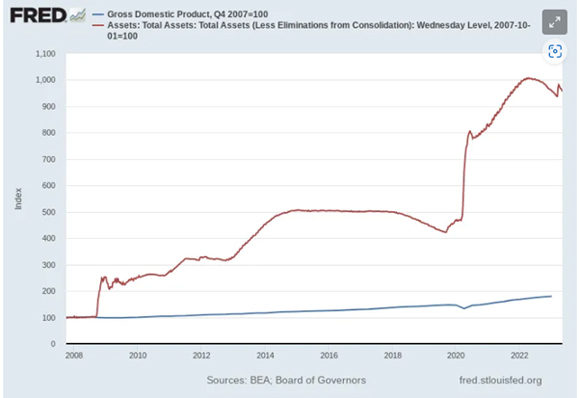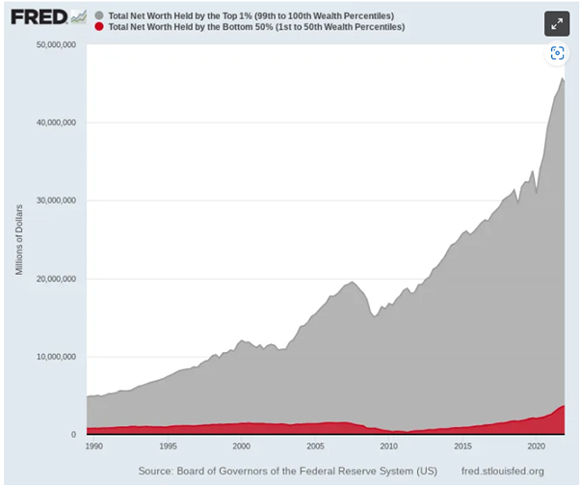The other day we got a call from Robert F. Kennedy, Jr., who is running for president.
He is curious…a rare quality for a politician. He wanted to know — what do we think? Why do we think that way? Herewith, we try to condense 25 years of on-the-go observations and guesswork into a carry-on bag.
Dear Robert,
Two little charts are all you need.
It took us 25 years to shuck off the nonsense and delusions of contemporary macroeconomics. Here, in less than 1,000 words, is the ‘executive summary.’
You lament, as we do, the decline of America’s decent, middle-class Republic. Basically, we’re talking about the kind of country we had in the ‘50s and early ‘60s. It was not perfect by any means, but by almost all measures the US was on top of the world…and pulling ahead. Real wages were rising, inflation was low, and consumers bought ‘Made in America’ not because it was a political slogan, but because American-made goods were the cheapest and best on the market.
It seemed inevitable, back then, that we would all be rich, happy, free and healthy by now. But something went wrong. Growth rates in the 21st century are less than half those of the 50s, 60s, and 70s. Real wages have been going down for the last two years and, measured correctly, the typical working stiff is worse off today than he was 50 years ago. Today, it takes him twice as long to buy an average car or an average house.
It would be reckless to try to pin the blame on a single person or a single thing. And many things are beyond our human control. But there was one major policy change that enabled the decline of America’s Main Street economy.
First, between 1968 and 1971, gold was removed from the US currency. For the first time, dollars could multiply much faster than the things they could buy. Second, in the 1990s, the Fed began manipulating interest rates to boost asset prices. These two moves destroyed America’s prosperity.
Gold — or something like it — is essential to a capitalist economy. It links our ‘money’ to the real world of time, work, and resources. Before 1971, if you wanted more money, you had to earn it by producing more goods or services (GDP). Then, you had ‘capital’ that you could invest to build new shops and factories to produce even more goods and services. That was how the US became the richest nation on earth.
But the post-1971 dollar led to a new form of wealth — financial wealth. It was capitalism without real capital. Instead, it was based on credit provided by the Fed and the banks. (Note: when you borrow from a bank, it doesn’t take the money out of its vault. It just creates the money, as credit, in an electronic ledger entry. The more you borrow, the more debt…and the more the ‘money supply’ goes up too.)
Atal financialization
This is what became known as the ‘financialization’ of the economy. People found that money could be made without adding to goods and services. Investing, speculating, leverage, Mergers & Acquisitions, IPOs, buybacks — all were ways to get rich, without adding a penny to the world’s real wealth. Emblematic of this era was Jack Welch. As chairman of GE, Welch turned the company — an old, industrial powerhouse — into a new financial wunderkind. He bought one new company every week, putting GE deeper and deeper into debt. Welch himself became famous for his hard-driving success. By 2000, GE stock was over $350 a share. And by 2005, Welch’s book, Winning, was, of course, a bestseller.
Deals, deals, deals…Wall Street brokered the deals and earned its cut. But what real wealth was added? It was hard to say. Here, we see what happened. The real economy stumbled along, while the ‘financial economy’ — powered by trillions of new dollars that no one ever earned or saved — soared.
We see here, in Chart #1, the two economies parting company:
|
|
| Source: David Stockman, BEA |
Penthouses and outhouses
‘Financial wealth’ is very different from real wealth. Real wealth must be earned. Until the 1980s, both rich and poor earned money and gained ground equally. Then, the new financial system tilted the playing field in favor of the elite. Those with good connections, good credit, business school diplomas, brokerage accounts, and business-class seats benefited the most.
The rich got much richer…while real wages stagnated. Here’s Chart #2.
|
|
| Source: David Stockman, Federal Reserve Board of Governors |
More and more, money was made by manipulating credit, not by learning a trade or building a business. ‘We think; they sweat’ was the delusional motto. Things of real value could be made cheaper and better by the Chinese, Koreans, Mexicans or Japanese. Let them do the hard work! All Americans had to do was borrow the money to buy their products. It worked well, for a while. Dollars were sent overseas to purchase real goods and services. Then, rather than come back to the US, where they would have driven up domestic prices, they were often locked away overseas as ‘reserves.’
Ambitious mommas wanted their sons to get in on it; they should grow to be hedge fund managers on Wall Street, not engineers in Detroit. But while the automotive engineer helped produce a better, safer car…what did financial engineering produce?
Regards,
 |
Bill Bonner,
For The Daily Reckoning Australia



